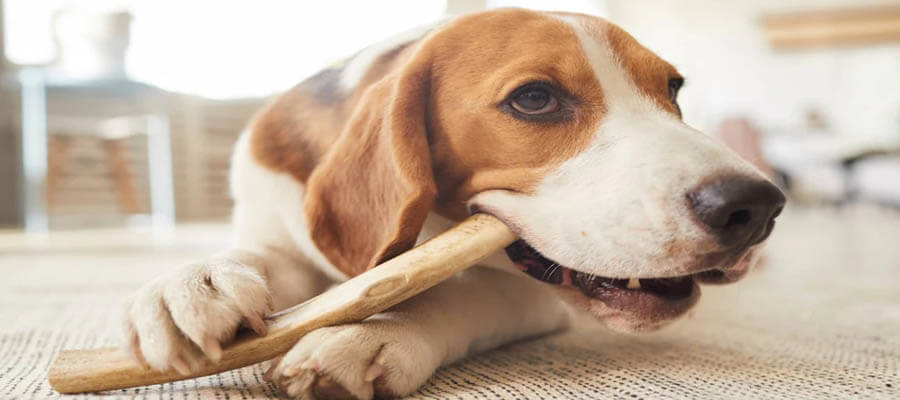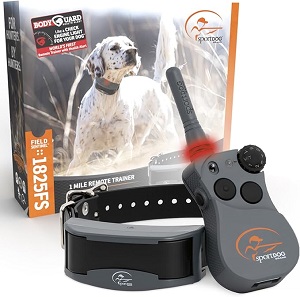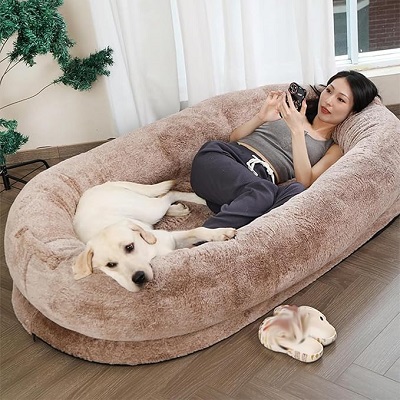
How to Stop Your Dog from Chewing on Furniture
Effective Ways to Stop Your Dog from Chewing
Dogs are curious creatures, and their natural instincts often lead them to chew on various objects around the house. While chewing is a normal behavior for dogs, it can become problematic when they target furniture, shoes, or other household items. Not only can this lead to damage in your home, but it can also pose health risks to your pet. Fortunately, there are effective ways to address this issue and redirect your dog’s chewing behavior. In this article, we’ll explore the reasons behind chewing, preventive measures, and training techniques to help stop your dog from chewing on furniture.
Understanding the Reasons Behind Chewing Before you can effectively address your dog's chewing habits, it's essential to understand the underlying reasons for this behavior. Here are some common reasons why dogs chew on furniture:
1. Teething Puppies go through a teething phase when their baby teeth fall out and adult teeth come in. This process can be uncomfortable and painful, leading puppies to chew on various objects to relieve their discomfort.
2. Boredom or Lack of Exercise Dogs are active animals that require physical and mental stimulation. If your dog isn’t getting enough exercise or has insufficient playtime, they may turn to chewing furniture out of boredom.
3. Anxiety or Stress Dogs can experience anxiety due to various factors, including changes in their environment, separation from their owners, or loud noises. Chewing can serve as a coping mechanism for anxious dogs.
Essentials for Your Newly Adopted Pet
Welcoming a shelter pet into your life is a beautiful journey. Here are some handpicked items to help your new friend feel safe, loved, and right at home:
4. Attention-Seeking Behavior Some dogs chew on furniture to get attention from their owners. If your dog notices that chewing results in your reaction, whether positive or negative, they may continue this behavior to get your attention.
5. Exploration Dogs explore their world through their mouths. Especially in puppies, chewing is a natural way to learn about their environment and discover new textures and tastes.
6. Hunger Sometimes, dogs may chew on furniture because they’re hungry or bored with their regular food. They might resort to chewing as a way to seek out food or attention.
7. Medical Issues In some cases, excessive chewing could be a sign of underlying medical problems, such as dental issues, allergies, or gastrointestinal problems. If your dog’s chewing is excessive and persistent, it's essential to consult your veterinarian.
Preventive Measures Now that you understand why your dog may be chewing on furniture, let’s explore preventive measures to address this behavior effectively.
1. Provide Appropriate Chew Toys One of the most effective ways to deter your dog from chewing on furniture is to provide them with appropriate chew toys. Look for toys specifically designed for chewing, such as rubber bones, dental chews, or plush toys. Ensure that the toys are safe and durable to withstand your dog’s chewing habits. Rotate toys regularly to keep your dog engaged and interested.
2. Establish a Routine Creating a structured daily routine can help reduce boredom and anxiety in your dog. Regular exercise, playtime, and mental stimulation can prevent destructive chewing behavior. Schedule daily walks, play sessions, and training exercises to keep your dog engaged and tired.
3. Redirect Chewing Behavior If you catch your dog in the act of chewing on furniture, immediately redirect their attention to an appropriate chew toy. Praise and reward them when they choose the toy instead of the furniture. Consistency is key; ensure you always redirect their chewing behavior to suitable items.
4. Use Bitter Sprays Bitter sprays are specially formulated to deter dogs from chewing on furniture. These sprays have an unpleasant taste that discourages dogs from chewing. Apply the bitter spray to the furniture you want to protect, following the product instructions. However, remember that some dogs may develop a tolerance to the taste, so it may not be a long-term solution.
5. Create a Chew-Proof Environment If you know your dog is prone to chewing on certain furniture, try to create a chew-proof environment. Consider using baby gates or barriers to restrict access to areas where you have valuable furniture. Additionally, move valuable or delicate items out of your dog’s reach until they learn proper behavior.
6. Provide Mental Stimulation Mental stimulation can help reduce boredom and prevent chewing. Engage your dog with puzzle toys, treat-dispensing toys, or interactive games that challenge their mind. Training exercises can also provide mental stimulation while reinforcing good behavior.
7. Practice Crate Training Crate training can be an effective way to manage your dog’s chewing behavior, especially when you’re not home to supervise them. A crate provides a safe space for your dog and prevents access to furniture. Be sure to introduce the crate positively, making it a comfortable and enjoyable space for your dog.
8. Limit Freedom If your dog has a history of chewing furniture, consider limiting their freedom in the house. Use leashes or baby gates to confine them to specific areas until they learn appropriate behavior. Gradually give them more freedom as they demonstrate good habits.
9. Increase Exercise and Playtime Regular exercise is crucial for a dog’s physical and mental well-being. Make sure to provide daily walks, play sessions, and opportunities for socialization. A tired dog is less likely to engage in destructive behaviors like chewing.
10. Seek Professional Help If your dog’s chewing behavior persists despite your efforts, it may be time to seek professional help. A professional dog trainer or behaviorist can assess the situation and provide personalized guidance tailored to your dog’s specific needs.
Training Techniques to Stop Chewing In addition to preventive measures, you can employ specific training techniques to discourage your dog from chewing on furniture.
1. Positive Reinforcement Training Positive reinforcement training involves rewarding your dog for desirable behavior. When you catch your dog chewing on their toys instead of furniture, provide immediate praise, treats, or playtime. This reinforces the idea that chewing on appropriate items is rewarding.
2. “Leave It” Command Teaching your dog the “leave it” command can be invaluable in preventing unwanted chewing. Start by holding a treat in your closed hand. When your dog tries to get it, say “leave it.” Once they stop trying and back away, reward them with a different treat. Repeat this process until your dog understands the command. Eventually, you can use this command when you catch them chewing on furniture.
3. Consistent Correction If your dog is caught chewing on furniture, provide a firm but calm correction. Use a consistent phrase like “no” or “leave it” and redirect their attention to an appropriate chew toy. Avoid yelling or using harsh tones, as this can cause fear and anxiety.
4. Time-Outs If your dog continues to chew on furniture despite your corrections, consider using time-outs as a training tool. Remove your dog from the area where the chewing occurs for a brief period. This can help them associate negative behavior with being isolated.
5. Desensitization If your dog is anxious or stressed, desensitization techniques can help. Gradually expose your dog to the situations that trigger their anxiety in a controlled and positive manner. Pair these situations with treats or praise to create positive associations.
Health and Safety Considerations When dealing with chewing behavior, it’s essential to keep your dog’s health and safety in mind. Here are a few considerations to ensure your dog stays healthy while you work on curbing their chewing:
1. Choose Safe Chew Toys Ensure the chew toys you provide are safe and appropriate for your dog’s size and chewing style. Avoid toys with small parts that could be swallowed or those that can easily break apart.
2. Regularly Inspect Toys Check your dog’s chew toys regularly for wear and tear. Discard any toys that are damaged or pose a choking hazard. Rotate toys to keep your dog interested while ensuring they remain safe.
3. Watch for Injuries Keep an eye on your dog while they chew to ensure they don’t accidentally injure themselves. If you notice any signs of distress, bleeding, or unusual behavior, consult your veterinarian.
4. Consider Dietary Needs If your dog is chewing on furniture due to hunger, ensure they are receiving a balanced diet that meets their nutritional needs. Consult your veterinarian for guidance on proper feeding schedules and portion sizes.
Conclusion Stopping your dog from chewing on furniture requires a combination of understanding, prevention, and training. By identifying the reasons behind your dog’s chewing behavior and implementing effective strategies, you can protect your furniture and create a positive environment for both you and your pet. Remember to be patient and consistent throughout the process, as behavior modification takes time.
Incorporate chew toys, establish routines, and provide adequate exercise and mental stimulation to redirect your dog’s energy toward appropriate outlets. If your efforts do not yield the desired results, don’t hesitate to seek professional assistance.
Ultimately, the goal is to foster a happy, healthy relationship with your dog while ensuring your home remains safe and intact. By taking the right steps, you can enjoy a furniture-friendly environment while allowing your furry friend to be the playful companion they are meant to be.
Affiliate Products
We may earn a small commission when you shop through our links — it helps us keep sharing love and care for every dog out there, at no extra cost to you.
Up to 75% Discount

Dog Collar with Health Monitoring
BUY NOW »
Up to 55% Discount

Luxury Faux Furhuge Napping Bed
BUY NOW »

